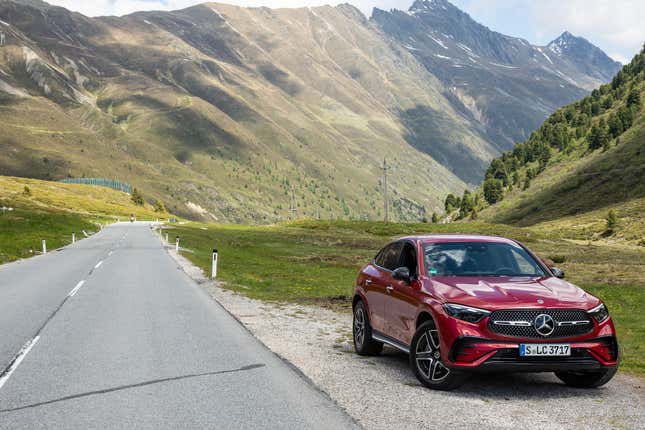The 2024 Mercedes-Benz GLC300 4matic Is Much Better To Drive

The GLC is an extremely important car for Mercedes-Benz, both in SUV and Coupé form. This new generation adds advanced digital features, a standard 48-volt system and more room to the premium crossover experience, while suspension and steering upgrades considerably improve the five-door’s handling.
According to Bob: Why the AMG C63 Hybrid Is So Goddamn Cool
Please bear with me, I’m back with another review mostly focused on a Mercedes-Benz you won’t get in the U.S. The U.S. car was present at the launch, but the car I spent the most time driving around Tyrol in happened to be the Mercedes-Benz GLC200 4matic Coupé —not the GLC300 4matic Coupé that will be arriving at U.S. dealers later this year. Thankfully, there isn’t much difference between the European entry-level gasoline powertrain and the 300 aimed at America. It’s the same two-liter four-cylinder, which produces 255 horsepower between 5,800 and 6,100 rpm, as well as 295 lb-ft from 1,800 up to 4,000 rpm in the GLC300. Thanks to the 48-volt mild-hybrid system boost, there’s also an additional 23 horsepower and 147 lb-ft available on demand.
The GLC200 has to make due with 204 horsepower and 236 lb-ft, yet with the air suspension and 4.5-degree rear-axle steering options ticked in, it offers a surprisingly fun ride across rather challenging alpine roads. This means the GLC300 you are getting is even better, given that it’s the same package, only with more power. I couldn’t try the standard steel-sprung suspension either, which features a four-link frontal setup with multi-link rear units, mounted to a subframe for better isolation from noise and vibrations.
The GLC is the multipurpose crossover offering from Mercedes-Benz, and the Coupé is the more dynamic version, both visually and in terms of driving characteristics. There is still an off-road mode, but that’s more about keeping the drivetrain at peak torque levels without raising the ride height, something the GLC SUV can do as an option. Up to 19-inch wheels, adaptive braking assistance and AMG styling elements complete the package.
In this class of vehicles, volume is everything, since size seems to be translating to status straight away. In terms of its actual dimensions, the new GLC Coupé got 1.2” longer and slightly taller as well, with an additional 1.6 cu-ft of trunk space behind second row seats and 3.1 cu-ft more with the second row seats folded down. Its width remains unchanged, while the car’s turning circle can be smaller with the optional rear-axle steering.
One thing that surprised me about the GLC Coupé is that ridiculous step bars aside, once inside the cabin, I felt completely at home. Not that I’m a fan of the squashed jet vents or the ambient lighting, but the seating position and the steering wheel felt perfect for somebody who is more focused on the drive than the augmented reality options on the 11.9” center touchscreen display.
The GLC Coupé also feels light on its feet, and while fake engine noises and constantly high revs make comfort mode more enjoyable than sport, one can select individual settings to get the most out of the four-cylinder with the nine-speed automatic. If you must know, the GLC300 4matic Coupé jumps to sixty miles per hour in 6.2 seconds, only to top out at an electronically limited 130 mph.
It’s not relevant for the U.S. market, but I also drove the gasoline plug-in hybrid version, mostly on a highway. It may be less eager to turn due to its weight penalty, but these electrified GLCs can also achieve roughly 75 miles in pure electric mode in such perfect weather as we got in Austria. Interestingly, Mercedes-Benz also makes a diesel plug-in hybrid for Europe, which has a combined range of at least 700 miles.
It’s fun to talk to proper engineers after driving the new cars. The GLC Coupé program had suspension specialist Dominik Vooght, as well as testing and development expert Peter Kolb. Both of them have been with Daimler for decades now, and I was curious to learn what their first projects were at Mercedes-Benz.
Vooght was lucky enough to start with the infamous first-generation A-Class, which failed a moose test completed in 1997 by Swedish automobile publication Teknikens Värld. As he explained, sneaking any level of comfort back into a suspension system that which was rather quickly firmed up post moose was their biggest challenge. Making the GLC ride in a very quiet yet controlled manner must have been a breeze compared to those days in the late Nineties.
Peter Kolb landed in the third-generation S-Class program, only to end up designing the chrome-based and plastic-covered door handles of the W140 for 1991. Today, he owns a 1988 300SL, while his daily tasks include developing the latest and greatest from Mercedes-Benz, starting from the first mule all the way to the pre-production vehicles.
Despite being taller, the Coupé turned out more aerodynamic as well. Having driven it for a day, I feel the GLC Coupé brings plenty of meaningful improvements to the table. It’s comfortable and more spacious, advanced in terms of digital functions thanks to the updated MBUX system, and most importantly, also entertaining to drive, even powered by the base engine. In the world of compact crossovers, that’s something.




